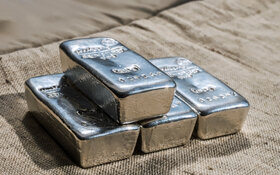The Gold Report: You recently told a crowd of investors at Prospectors & Developer Association of Canada (PDAC) that precious metals are the best place to invest in an inflationary period. Why is that?
Leonard Melman: When prices are going up, you wouldn't want to be in housing stocks or auto financing, but you would certainly want to be in precious metals. You also might want to short the bond market. That is why you have to be aware of the direction of inflation. It is important to the concept of precious metals pricing. If you've been around for a few years, as I've been lucky enough to be, then you can easily recall a time when high inflation was the absolute key ingredient in massive previous bull markets. That is why I thoroughly look at what has led to past inflation and hyperinflation. I use four examples: the Roman Empire, the French Revolution in the late 1700s, the German hyperinflation in the 1920s and the recent catastrophe of hyperinflation in Zimbabwe. I examine whether America and other countries in the world are perhaps following the same paths that led to those previous hyperinflations.
TGR: Do you think investors are going to see hyperinflation in the foreseeable future?
LM: Not immediately. It's like a doctor looking at a patient who is showing all the early signs of cancer, but the actual tumor hasn't yet developed. It would be unwise to ignore those developing symptoms. That's where I think we are. We don't have hyperinflation yet, but many of the pathways that led to previous hyperinflations are present, and I think it would be very foolish to ignore them.
TGR: In a recent edition of The Melman Report, you quoted Patrick Armstrong, head of investment selection at Armstrong Investment Managers, as saying, "We think a currency war will be the biggest story of 2013." How is that likely to affect precious metals equities?
LM: There has been a lot of coverage about currency wars recently. So far the main participants have been countries like Japan and the European community, which are very concerned that strength in their currencies is going to limit their ability to export goods at a profitable rate. Japan has recently done everything it can to lower the value of its currency and the euro is now entering a new period of weakness. So far, the one currency that hasn't played this game is the U.S. dollar. The other currencies look weak compared to the U.S. dollar. When the U.S. dollar looks strong, usually gold and silver perform poorly, which we are seeing now. As the year progresses, the dollars' immunity will soften, which should spill over into higher precious metals prices.
TGR: Gold has fallen below the $1,600 per ounce ($1,600/oz) support level. What is your macro picture for gold?
LM: I'm not one to ignore charting. I'm a member of the Canadian Society of Technical Analysts. I can't ignore the weakness that gold is showing. However, I believe powerful forces, such as inflation and currency devaluation, are going to appear stronger in the future. That should lead to higher gold prices over the second half of the year.
"As the year progresses, the dollars' immunity will soften, which should spill over into higher precious metals prices."
Another factor is that countries are now repatriating their gold holdings. Germany just announced it is going to be bringing back much of the gold now held in foreign storage, particularly in France and in America. Venezuela just repatriated all its foreign gold holdings and Switzerland is now moving forward with a referendum on whether it should reform or repatriate all its gold holdings held in foreign lands. A lot of underlying pressures will be positive for gold and silver ultimately.
TGR: Do you believe that the timeframe for Germany's repatriation of its gold has a lot to do with the fact that its gold may not actually be where it's supposed to be?
LM: Of course, that's one of the most important questions this is addressing. I find it very interesting that there has not been an audit of the United States government-controlled physical gold holdings in facilities such as Fort Knox or Federal Reserve vaults in more than 33 years. Can you imagine a private company getting away without allowing an audit of its books for that length of time? That is what the government has done.
If the gold isn't really there, a sudden buying surge could occur as guarantors scramble to fulfill the demands.
TGR: Do you see gold continuing to trend lower through 2013?
LM: I'm looking for the long-term bullish forces to exert themselves during the second half of the year, particularly in the last quarter. There is a great deal of gloom and doom for metals at the moment. The gold share indexes, like the Philadelphia Gold and Silver Index (XAU), the Amex Gold BUGS Index (HUI) and the Market Vectors Gold Miners ETF (GDX), are all in virtual freefall. But wasn't it Baron Nathan Rothschild who once said, "Buy when there's blood in the streets?" Usually isn't that what happens? A selling climax terrifies everyone and then, all of a sudden, with surprising swiftness, prices begin to recover and head higher.
We may be in the process of that now because the selling is absolutely pervasive. Such a selling climax could easily be followed by stronger markets in the second half of the year.
TGR: Silver is falling too, though slower than gold. What's your outlook for silver?
LM: I would dispute that statement. Silver peaked in the summer of 2012 at $37.50/oz and it's trading at $28.50/oz this morning. That's a $9/oz difference, a 20+% decline. In the same time, gold has fallen from $1,800/oz to about $1,580/oz. That's $220/oz, which is only about 12%, so silver is making a much greater percentage move to the downside.
"I'm looking for the long-term bullish forces to exert themselves during the second half of the year, particularly in the last quarter."
I recently completed a chart analysis comparing the five-year charts of gold and silver and the timing of the moves is virtually precise. When gold makes a bottom, silver makes a bottom. When gold makes a relative high, silver makes a relative high. But in virtually every case, silver's move is exaggerated on a percentage basis. The reason is that it takes less money to move silver than it does to move gold and therefore you get bigger percentage moves.
The same thing will hold true in the next bull market wave—gold will rally. Silver will rally in a greater percentage. Also remember, silver is an industrial metal and the beneficiary of many new scientific advances, which are increasing the demand for silver.
TGR: Where are you seeing value in the junior mining equity space right now? What types of companies will be able to ride this out?
LM: Several companies have entered production over the last year and once they have cash flow coming in, they can use it to develop their projects or build up their cash balances, thereby eliminating the need to look for financing. Those companies are in the best shape. Also, during the last couple of years several companies have adopted the royalty model, helping other companies get their projects into production and in return receiving royalties. Outside revenue options have been key for company survival.
One of the symptoms of the problems facing many juniors is a lack of cash and this shows up in the number of equity offerings in relatively small amounts, $200,000–400,000, rather than several million dollars. When I see those, I suspect that the biggest problem is just keeping the doors open. Those companies are in a difficult position and unless we get a rally quickly they may be in trouble.
TGR: When you last talked with The Gold Report, you discussed Orko Silver Corp. (OK:TSX.V), which has since had several takeover bids with Coeur d'Alene Mines Corp. (CDM:TSX; CDE:NYSE) looking like the successful acquirer. What are the takeaways from those competing bids?
LM: Orko is a company I've been familiar with for some years and I have a very sound working relationship with Ben Whiting, the chief geologist. Orko's strength came from the depth of its exploration and development, which took place over about a 7–10 year period, where it proved very sizable reserves, making it attractive to companies like First Majestic Silver Corp. (FR:TSX; AG:NYSE; FMV:FSE) and Coeur d'Alene.
Despite the difficult share price environment, companies believe Orko could develop into a very profitable mining venture and that is why it was so attractive.
It's been a very profitable venture for Orko's shareholders as the price bottomed earlier in the year at just above $1/share and now they are getting $2.70 equivalent value for their shares. That's not a bad deal at all.
TGR: What are some silver plays that you are following?
LM: SilverCrest Mines Inc. (SVL:TSX.V; SVLC:NYSE.MKT) and Great Panther Silver Ltd. (GPR:TSX; GPL:NYSE.MKT) are two companies that I have followed for some time. SilverCrest has a productive mine in Sonora, Mexico, the Santa Elena, but it also has a very good prospective property, the La Joya in Durango. The company is using revenue developed from Santa Elena to finance exploration and development at La Joya. It is building value and the share price has reflected it.
TGR: SilverCrest recently doubled the contained silver equivalent ounces at its La Joya project from about 102 million ounces (102 Moz) silver equivalent to 198.6 Moz. Is that enough to create interest among the small-cap producer set?
LM: It's enough to develop substantial interest if SilverCrest is aiming toward having the project bought out. But it's also worth noting that SilverCrest is working to steadily increase production at Santa Elena. As long as it can obtain increasing rates of positive cash flow, it might be very interested in keeping the La Joya project and advancing it toward production. I don't know if that decision has been made yet, but it could be attractive as a potential buyout for the La Joya, or as a possible candidate for production.
TGR: And Great Panther?
LM: Great Panther accomplished the same thing a few years ago. Its goal now is to continue to increase production and increase value through advancing other areas of exploration. The stock has moved sideways lately. Its mining operations have not been without some problems, but it appears to have the reserves. It has production capacity. It's a worthwhile company for people to take a look at.
TGR: Great Panther is currently trading at around $1.12/share and, as you said, it's been trading sideways since the fall. SilverCrest has suffered some bumps along the way, but is generally on the rise. Has Great Panther's share price weakness made it a target?
LM: It could. If Great Panther is interested in entertaining offers, I believe there are offers out there. It has both the reserves and production capacity and that combination could make it very attractive to any company, but especially to a major. The majors are looking to replace the reserves they are going through. Companies like Great Panther could be on the shopping list.
TGR: Are there any other silver companies you would like to talk about?
LM: Well, one of the companies worth a look is El Tigre Silver Corp. (ELS:TSX.V; EGRTF:OTCQX; 5RT:FSE). El Tigre is a combination of many things. First, it has the potential for early cash flow because one of the values of its property is an immense tailings pile. It was left behind from mining operations that went on from 1905 to 1935. The operations handled ore, which was rated at as much as 40 ounces per ton (40 oz/ton), so when the miners of that era came across tailings that were only 3–4% silver, they deemed them completely not worth looking at. As much as 800,000 tons piled up through the years and El Tigre is planning to bring those into production.
"It takes less money to move silver than it does to move gold and therefore you get bigger percentage moves. "
The last time I talked to Stuart Ross, El Tigre's president and CEO, the company was already assembling equipment and expertise to bring those into production at the earliest possible time. It's looking at actual revenue production before the end of 2013. In the meantime the company has two goals for exploration on the property. One is exploring for gold, which it believes could be quite substantial, but it is also searching areas close to where the 40 oz/ton silver had been located during the first mining event in the hope of hitting some of those bonanza grades. There is both the productive end to it and a good potential exploration end. On a risk/reward basis El Tigre is a stock that people should take a look at.
TGR: Will the production be enough to continue to finance El Tigre's exploration?
LM: I believe it will. We're talking about 800,000 tons of tailings. If the company is recovering 2.5 oz/ton from 800,000 tons, we're talking about 2 Moz silver. Even at today's market value, that's gross revenue of between $55 million ($55M) and $60M. With lower costs, even if El Tigre had to crush the ore, you can see that there is potential for very substantial net cash flow.
By the way, there's also another important point about the tailings. There is as yet an undetermined amount of tailings, which were used as underground fill during the early mining operations. Some of those tailings could be of a much higher grade than just 3 oz/ton. The company also has discovered some areas of 7 oz/ton and 8 oz/ton. So, the potential for revenue could be more than is just evident by the 800,000 tons in the big pile.
TGR: Do you have any other updates on companies?
LM: When we talked last time I spoke about Commerce Resources Corp. (CCE:TSX.V; D7H:FSE; CMRZF:OTCQX) and Zimtu Capital Corp. (ZC:TSX.V), which both share the same president.
I just met with Chris Grove, a director at Commerce. Chris was telling me that Commerce has completed preliminary economic assessments (PEAs) on both its tantalum project at Blue River, British Columbia, which is tantalum and niobium, and its rare earth element project in Northern Québec, the Ashram project, also known as the Eldor project. The next goal is to advance metallurgical studies on those projects. That work is underway at the moment so within whatever cash constraints are evident in the industry the company is still moving forward. The fact that Commerce has achieved two PEAs on widely separate projects is a very positive feature. It could conceivably make the company very attractive to end-user companies, which currently rely on China for rare earth elements. China appears to be very shaky looking forward as a source for those materials. Companies will be looking for North American sources and I think Commerce could be sitting in the right position.
TGR: Commerce recently announced that in testing it had doubled its concentrate grade from about 20% to 40% total rare earth oxides. It did so by using a new technology called wet high intensity magnetic separation. Commerce is claiming this is the highest grade concentration of any developing rare earth project. If so, it could make Commerce the preferred supplier of concentrate the world over because 40% concentrate is quite a high grade.
LM: In the rare earth field that would be exceedingly high.
TGR: What can you tell our readers about David Hodge, president of Commerce and Zimtu Capital?
LM: I have known Dave for quite a few years. Aside from his booming voice, he's been instrumental in helping numerous mining companies find the funding to advance projects. Commerce was one of those companies that has come a long way under his leadership. He's very active in the mining industry and very aware of developments. Through Zimtu he has been a substantial positive influence, which has moved several projects a long way forward.
TGR: It doesn't hurt these days to have a financing arm connected to your company.
LM: Zimtu's business is advancing junior projects. What it does is accumulate an inventory of junior projects and then market them out to groups that look as if they're in a position to advance the projects. Zimtu has the capital available to acquire potential projects at rock bottom prices and build up the inventory of projects that can be farmed out to new sources of capital. The growing availability of new projects coming to market at discounted prices due to their owners' financial difficulties could enhance the workability of its game plan very substantially going forward.
TGR: What's happening in Cambodia?
LM: Angkor Gold Corp. (ANK:TSX.V) is a very interesting story. Perhaps the most interesting feature is that Angkor Gold is the earliest development company to enter into Cambodian mining development. It has a huge, 2,000 square kilometer holding. It started originally as a simple mining exploration and development venture, but has recently gone into project generation, including the building of future royalties. Those project developments have recently brought in more than $2M to the treasury and created a royalty base of 10% of any silver or gold produced from the new projects. It's changing direction to bring in current revenue, so it doesn't have to go to the financial markets to sustain its own exploration work. Angkor Gold is also insisting upon a royalty stream down the road if those projects enter production.
TGR: Angkor Gold was also seeking copper-gold porphyry targets. Have they made any progress toward finding a large copper-gold porphyry system?
LM: That is what I'm looking for right now. The company's total property holdings are in eight different areas and some of them show the potential for copper, gold and molybdenum. The potential is there. The company is just in the early stages of a lot of its exploration, but the potential is very definitely there in several directions.
TGR: Thank you, Leonard, for your insights.
Leonard Melman, publisher of The Melman Report, has been writing about precious and base metals for more than two decades as monthly columnist for California-based ICMJ's Prospecting and Mining Journal and Vancouver's Resource World Magazine. He focuses on how political and financial considerations impact the world of mining and the prices of the metals.
Want to read more Gold Report interviews like this? Sign up for our free e-newsletter, and you'll learn when new articles have been published. To see a list of recent interviews with industry analysts and commentators, visit our Streetwise Interviews page.
Disclosure:
1) Brian Sylvester conducted this interview for The Gold Report and provides services to The Gold Report as an employee or as an independent contractor. He or his family own shares of the following companies mentioned in this interview: None.
2) The following companies mentioned in the interview are sponsors of The Gold Report: Angkor Gold Corp., Great Panther Silver Ltd., SilverCrest Mines Inc., Zimtu Capital Corp. and Commerce Resources Corp. Streetwise Reports does not accept stock in exchange for its services or as sponsorship payment.
3) Leonard Melman: I or my family own shares of the following companies mentioned in this interview: None. I personally or my family am paid by the following companies mentioned in this interview: None. My company has a financial relationship with the following companies mentioned in this interview: SilverCrest Mines Inc., Zimtu Capital Corp., Commerce Resources Corp. and Angkor Gold Corp. I was not paid by Streetwise Reports for participating in this interview. Comments and opinions expressed are my own comments and opinions. I had the opportunity to review the interview for accuracy as of the date of the interview and am responsible for the content of the interview.
4) Interviews are edited for clarity. Streetwise Reports does not make editorial comments or change experts' statements without their consent.
5) The interview does not constitute investment advice. Each reader is encouraged to consult with his or her individual financial professional and any action a reader takes as a result of information presented here is his or her own responsibility. By opening this page, each reader accepts and agrees to Streetwise Reports' terms of use and full legal disclaimer.
6) From time to time, Streetwise Reports LLC and its directors, officers, employees or members of their families, as well as persons interviewed for articles and interviews on the site, may have a long or short position in securities mentioned and may make purchases and/or sales of those securities in the open market or otherwise.










































